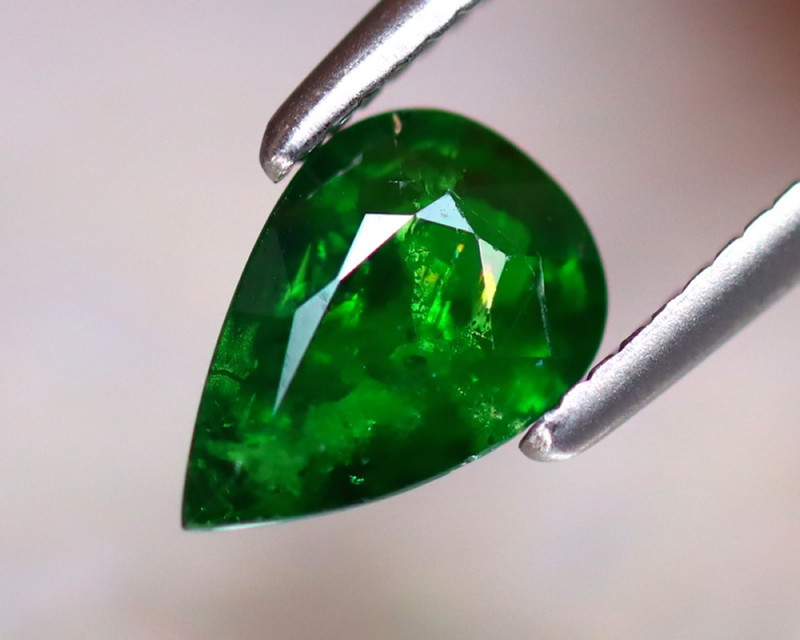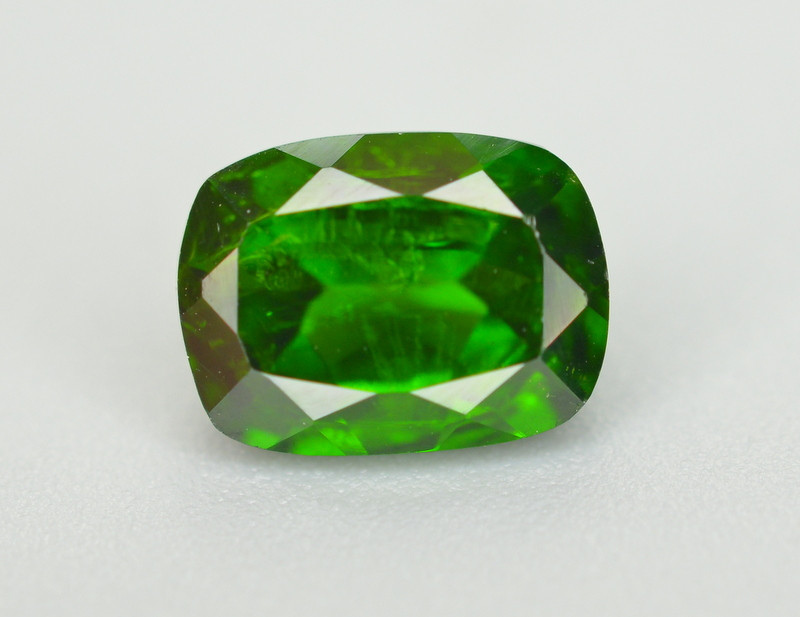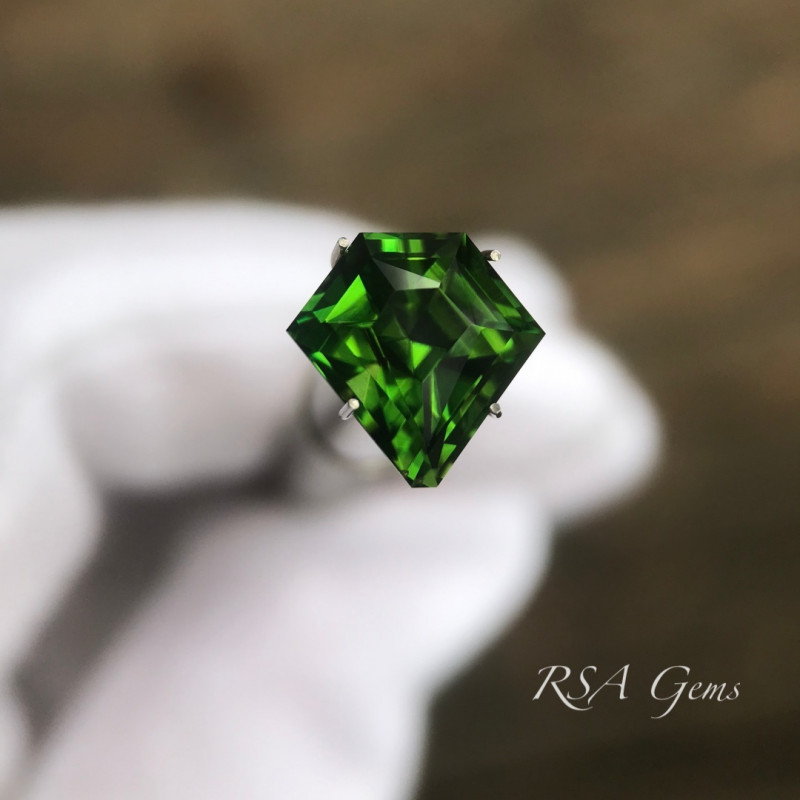
Chrome Tourmaline Gemstone: Properties, Meanings, Value & More
 Chrome tourmaline is a type of tourmaline gemstone known for its lush green hues. This tourmaline variety was only officially discovered in the late 1900s.
Chrome tourmaline is a type of tourmaline gemstone known for its lush green hues. This tourmaline variety was only officially discovered in the late 1900s.
Is chrome tourmaline rare? Generally, yes. Though not as rare as varieties like Paraiba tourmaline or rubellite, chrome tourmaline is much rarer and more sought-after than other types of green tourmalines. It’s even rarer than tsavorite garnet and emerald!
You might wonder: what is the rarest color of tourmaline? Spoiler alert: it’s not green. It’s actually blue! But green tourmalines that classify as chrome tourmaline are still rare.
Intrigued? Then stick around to find out all about chrome tourmaline gemstone prices, properties, and powers. By the end, you’ll have all the info you need to shop for chrome tourmalines with confidence.

What Is A Chrome Tourmaline?
Chrome tourmaline (sometimes called “chromium tourmaline”) is a green tourmaline defined by its coloring agents: chromium and sometimes vanadium.
What does chrome tourmaline look like? Despite being a semi-precious gemstone, chrome tourmaline can display rich green hues that give the precious gemstone emerald a run for its money.
As a tourmaline, this gem is an October birthstone, Libra zodiac stone, and 8th wedding anniversary gem. Individually, chrome tourmaline is a zodiac stone for Sagittarius.
Given its resemblance to emerald at a lower price point, chrome tourmaline can serve as a more affordable May birthstone or 20th wedding anniversary gem alternative.
Wondering how emerald and chrome tourmaline differ? We’ll tell you, but first you’ll need to know about chrome tourmaline’s individual mineral properties.
Chrome Tourmaline Specifications & Characteristics
Tourmaline is a broad, complex gemstone family with multiple groupings and varieties. While most gem-quality tourmaline varieties are in the elbaite species (or series), chrome tourmaline is one of the few in the dravite species.
Dravite tourmalines are rich in sodium and magnesium. They’re often called “brown tourmalines,” as dravites are typically dark yellow to brown. However, they can also be dark red, yellow, light cyan, black, colorless, and of course, deep green.
As a dravite, chrome tourmaline is diamagnetic, meaning it’s repelled by magnets.
The ideal formula for this chrome dravite is NaMg3Cr6Si6O18(BO3)3(OH)3OH.
Some rare chrome tourmalines from western Australia are euhedral — having distinct, well-formed crystal faces — which is a rare property in tourmalines.
Below are the remaining chrome tourmaline properties:
Mohs hardness: 7-7.5
Color: Shades of green, typically medium to high saturation
Crystal structure: Hexagonal (trigonal)
Luster: Vitreous (glassy)
Transparency: Transparent to opaque
Refractive index: 1.615-1.655
Density: 3.00-3.26
Cleavage: Poor, 2-directions
Fracture: Conchoidal or uneven
Streak: White
Luminescence: Fluorescence sometimes present but weak
Pleochroism: Present & strong - Dark green to yellow-green
Birefringence: 0.018-0.020
Dispersion: 0.017 (moderate)
Optical effects: Sometimes chatoyancy
With those properties in mind, let’s see how chrome tourmaline’s traits stack up against similar stones like chrome diopside, emerald, and tsavorite.
Chrome Tourmaline vs. Similar Gems
Chrome tourmaline’s similarity to other gems goes beyond just emerald — you might mix it up with chrome diopside, tsavorite garnet, or even other green tourmalines.
Let’s start with emeralds.
 Pictured above: Emerald
Pictured above: Emerald
Chrome Tourmaline vs. Emerald
Both chrome tourmaline and emerald are colored by chromium and sometimes vanadium, and both are popular gems. However, their differing semi-precious vs. precious statuses are just one of their many differences.
For one, emerald is a variety of beryl, a beryllium aluminum silicate distinct from tourmaline.
Secondly, emeralds are actually less rare than chrome tourmaline. Value-wise, however, chrome tourmaline is almost always less expensive.
For identification, hardness is one distinguishing factor. Emeralds rank at 7.5 to 8 on the Mohs mineral hardness scale, slightly higher than chrome tourmalines.
While chrome tourmalines usually have better clarity than emeralds, they’re also typically darker-colored.
 Pictured above: Tsavorite
Pictured above: Tsavorite
Chrome Tourmaline vs. Tsavorite
Another beloved gem confused with chrome tourmaline is tsavorite garnet. Both stones primarily come from East Africa and share similar green hues with yellow to blue undertones. Tsavorite’s green similarly comes from vanadium and sometimes chromium.
Like most of these comparisons, the first difference is gem species. Tsavorite is a variety of grossular garnet, completely separate from tourmaline.
Next is rarity. Though similarly semi-precious, tsavorite is actually rarer than emerald but not as rare as chrome tourmaline. However, chrome tourmaline is significantly less expensive than tsavorite.
Next, what is the difference between chrome diopside and chrome tourmaline?
 Pictured above: Chrome diopside
Pictured above: Chrome diopside
Chrome Tourmaline vs. Chrome Diopside
By names alone, it’s easy to mix up chrome tourmaline and chrome diopside. Both get their green color from chromium and sometimes vanadium, like emeralds.
The biggest difference is their gem family. Chrome diopside is a variety of diopside, a monoclinic, calcium magnesium silicate distinct from tourmaline.
A second difference is rarity (and thus, value). Chrome diopside is much more abundant and affordable than chrome tourmaline.
In terms of identification, you can look at each stone’s hardness. Chrome diopside only ranks at 5 to 6 on the Mohs scale, lower than chrome tourmaline. That also means a chrome tourmaline ring is more durable than a chrome diopside ring.
Lastly, what is the difference between green tourmaline and chrome tourmaline?
 Pictured above: Verdelite tourmaline
Pictured above: Verdelite tourmaline
Chrome Tourmaline vs. Green Tourmaline
Though Paraiba tourmalines can be green and indicolites often have green undertones, most green tourmalines fall under the verdelite variety.
Verdelite tourmaline, nicknamed “green tourmaline,” includes basically all green shades. The exception is greens caused by chromium impurities, distinguishing verdelites from chrome tourmaline. Due to their chromium content, chrome tourmalines generally have more saturated colors.
Vanadium impurities may be present in either type of green tourmalines, but most non-chrome green tourmalines are colored by iron and titanium.
Like chrome diopside, another difference is rarity (and thus, value again). Chrome tourmaline’s greens are considered the best possible green shades for tourmaline, raising its value.
Chrome tourmaline’s rarity extends to its size, with smaller sizes available and bigger price-per-carat jumps than other green tourmalines.

Chrome Tourmaline Meaning & History
Chrome tourmaline symbolizes joy, generosity, and hopefulness. Its deep green hues evoke ideals of new beginnings, balance, and growth.
Since it’s a newer find in the tourmaline family, chrome tourmaline doesn’t have much folklore associated with it.
History
Perhaps unsurprisingly, chrome tourmaline’s name comes from its chromium content.
The first record of chrome tourmaline came from H. Bassett’s report in the 1956 edition Jeweler’s Quarterly on the new tourmaline variety from Tanzania. The new tourmalines differed from other green tourmalines, like those from Brazil, with a more pure green color.
The trade name “chrome tourmaline” came about because mineralogists assumed chromium was behind the color. Funny enough, Bassett’s analysis led him to theorize that vanadium was the color’s true cause.
In 1982, H. Bank similarly reported not finding much chromium in the chrome tourmalines from East Africa. However, Bank’s later research with U. Henn revealed more chromium than vanadium in Tanzanian specimens tested after Bank’s initial analyses. Bank and Henn published their updated analysis in the 1988 issue of Journal of the German Gemological Society.

Chrome Tourmaline Healing Properties
Like all gems, chrome tourmaline can function as a healing stone. The crystal’s green coloring means it possesses the balancing and nurturing properties inherent to green gemstones.
Additionally, green stones like chrome tourmaline are great heart chakra stones, opening this energy center to bring you love and acceptance.
Physical Healing
Crystal healers recommend using chrome tourmaline to help with:
Arthritis & joint pain
Immune system function
Infection prevention
Heart problems
Emotional Healing
Emotionally, chrome tourmaline is said to help you heal from heartbreak or grief. They can also help you understand yourself and the world better, along with boosting self-esteem and focus.
Beyond healing, is green tourmaline valuable? Each tourmaline stone’s value is graded based on certain properties.

Chrome Tourmaline Gemstone Properties
Chrome tourmaline’s value depends on its color, cut, clarity, carat weight, treatments, and authenticity.
Color
The best chrome tourmaline color is usually a medium emerald-green, though preferences differ. For instance, pastel color trends may raise demand for mint green chrome tourmaline. Pure greens are most valuable, though blue-greens are still valuable. Yellow undertones are less valuable.
Like the copper content that defines Paraiba tourmalines and gives them their signature bright hues, chromium and vanadium are the secret to chrome tourmaline’s emerald-like coloring.
Cut
Chrome tourmaline is available in a wide range of cuts. For darker stones, lapidaries must choose faceted cuts that bring out the saturation and don’t let the dark tone hide chrome tourmaline’s sparkle or pleochroism.
Common cuts for darker stones are brilliant or checkerboard shapes, while generally popular cuts for chrome tourmalines include trillion, cushion, round, and oval shapes.
Lower-quality material may be cut as cabochons or carved. Specimens with chatoyancy (the “cat’s eye” effect) must be cut as cabochons to display the effect.
Clarity
Unlike many other tourmalines, chrome tourmaline has a Type I colored gemstone clarity grade, meaning most specimens don’t have visible inclusions. Visible inclusions will lower value.
Inclusions that may be present include:
Color zoning
Long, thin liquid and/or gas inclusions
Reflective fractures filled with gas
Carat Weight & Size
Good-quality, faceted chrome tourmaline gemstones are usually 1-2 carats. Stones weighing 8 carats or more are rare, especially gem-quality ones. Chrome tourmaline’s price-per-carat generally increases above 1 carat.
Treatments & Simulants
In contrast to most tourmaline varieties, chrome tourmaline is not routinely heated or irradiated. Some darker specimens are heated to be lighter, but this isn’t common.
More often, other green tourmalines are treated and sold as chrome tourmalines. You can check the authenticity by looking for red or pink under a Chelsea filter, confirming chromium is present.
Other stones sometimes used as chrome tourmaline simulants include dyed quartz or spinel.
Chrome Tourmaline Formation & Sources
Most tourmalines form in granite pegmatites, granite, schists, and marble. Dravites like chrome tourmaline are usually only found in metamorphic rocks like marble and schists.
The crystal’s formation starts when water carrying dissolved elements settles into crevices of rocks. The water then evaporates, leaving the elements behind to crystallize. In this case, chromium must be present for chrome tourmaline to form.
Mining Locations
The number-one source for chrome tourmaline gems is Tanzania. Other sources are:
China
Kazakhstan
Kenya
Myanmar
Nigeria
Before we start wrapping up, we have to talk about what prices to expect for chrome tourmaline.


Chrome Tourmaline Price & Value
Given its rarity and popularity, chrome tourmaline gemstones can carry a relatively high price. For faceted chrome tourmaline, price-per-carat ranges are $100 to $500 per carat in 0.5- to 1-carat stones. Gems weighing 1 to 5 carats are $100 to $2,000 per carat.
Chrome tourmaline cabochons generally cost $20 to $50 per carat. Cat’s eye cabochons are slightly higher and change by weight category:
0.5 to 1 carat: $35 to $100 per carat
1 to 5 carats: $35 to $200 per carat
5+ carats: $35 to $400 per carat
Wholesale prices for raw chrome tourmaline range from around $2 to $20 per carat.
Chrome Tourmaline Care and Maintenance
Chrome tourmaline gemstone care is pretty straightforward. Virtually any jewelry option for chrome tourmaline is good for everyday wear, with or without protective settings.
You can clean chrome tourmaline with the standard soft toothbrush, lukewarm water, and mild soap. Rinse any soap residue away and dry it with a soft cloth.
Store your chrome tourmaline away from other gems to prevent scratches.

Charmed By Chrome Tourmaline?
It may not come up as much as Paraiba tourmaline or rubellite, but chrome tourmaline isn’t a tourmaline to overlook. If your budget is tight, you can always opt for a verdelite tourmaline — but if you have the means, chrome tourmaline is a luxurious stone comparable (and less expensive) to even legendary emeralds.
Search the Gemstone Encyclopedia
Related Auctions
Related Articles
Originally the Birthstones or gemstones were associated with a zodiac sign or the month of a individuals birth. Find out what your stone is and view the stones we have for sale
8th Feb 2021
There are dozens of quartz and chalcedony gems with various colors and patterns. Learn all about quartz properties and every type of quartz, from amethyst and agate to plasma and phantom quartz!
15th Oct 2020
Hackmanite is a pink to violet sodalite gem known for its unique color-change and luminescence. Learn why hackmanite is special, from its rare qualities to the types of hackmanite jewelry available.
28th Mar 2018
Latest Articles
Yugawaralite is a rare colorless, white, or pinkish zeolite crystal named for its discovery in Yugawara, Japan. Here we uncover the multifaceted history, properties, prices, and uses of yugawaralite.
24th Mar 2025
Simpsonite is a lesser-known mineral known on the gem market for its durability, yellow-orange color, and rarity. Discover all the properties, uses, prices, and history of simpsonite.
3rd Mar 2025
Kurnakovite is a colorless crystal related to inderite and rarely faceted but known among collectors. Explore the mineral traits, history, prices, and more in this kurnakovite guide.
17th Feb 2025
Article Categories
How To's is where you will find helpful articles from gem Rock Auctions on how to cut gemstones, select gemstones and buy gemstones.
9 Articles





